Impact of Casualisation on Customer Service at Coles Australia
VerifiedAdded on 2023/06/14
|13
|3618
|332
Report
AI Summary
This business report addresses the increasing level of casualisation within Coles Supermarket Australia, particularly among frontline staff and supervisors, which is suspected to be impacting customer satisfaction. The report examines the positive and negative impacts of casualising employment conditions, such as increased staffing flexibility versus decreased employee commitment and product knowledge. It identifies that while casualisation can provide cost-effective staffing solutions and enthusiastic employees, it also leads to issues like low wages, lack of training, and reduced customer loyalty. The report suggests that limited career opportunities and extended retail trading hours contribute to casualisation. Ultimately, the report aims to provide recommendations to strengthen frontline performance and improve customer service within Coles, focusing on balancing the benefits and drawbacks of a casualised workforce.
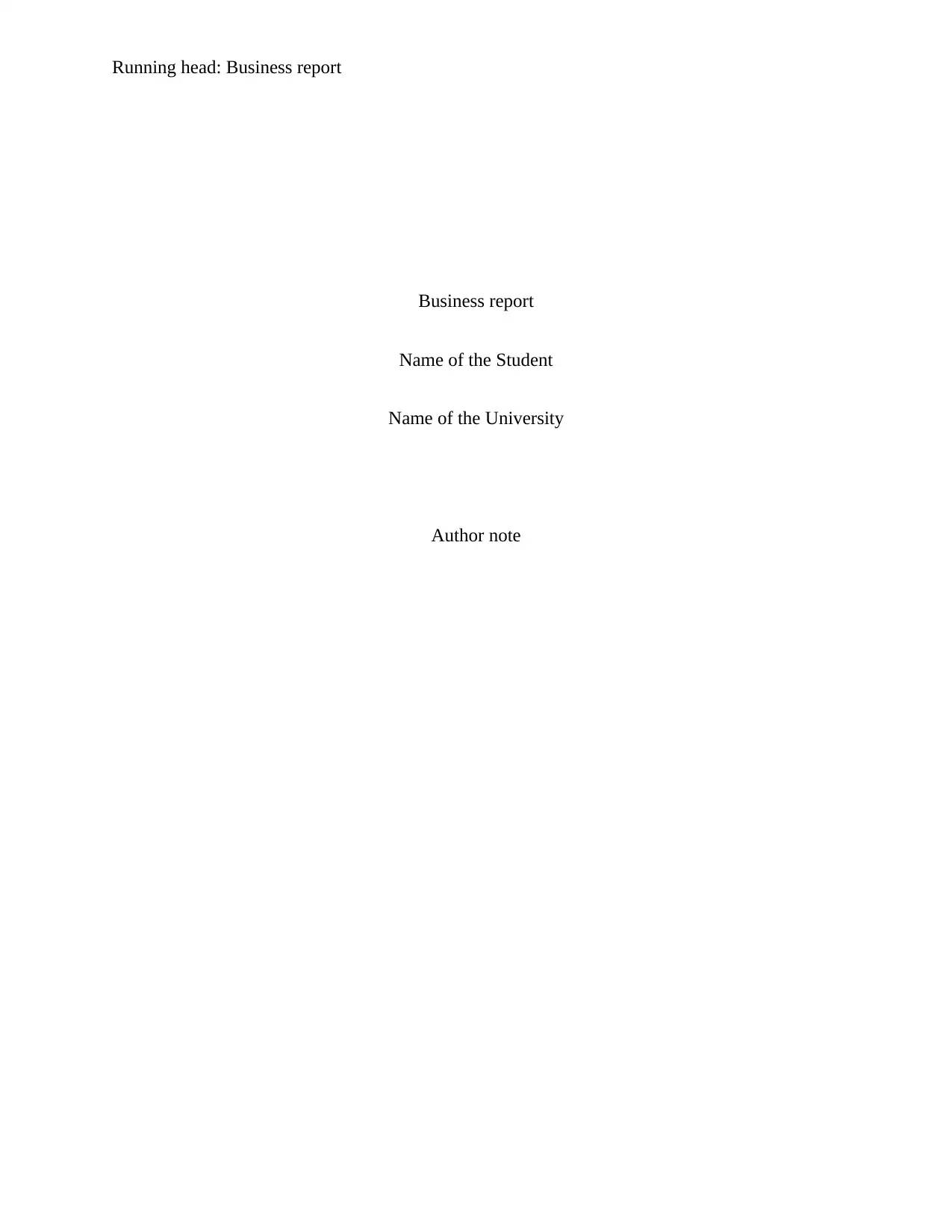
Running head: Business report
Business report
Name of the Student
Name of the University
Author note
Business report
Name of the Student
Name of the University
Author note
Paraphrase This Document
Need a fresh take? Get an instant paraphrase of this document with our AI Paraphraser
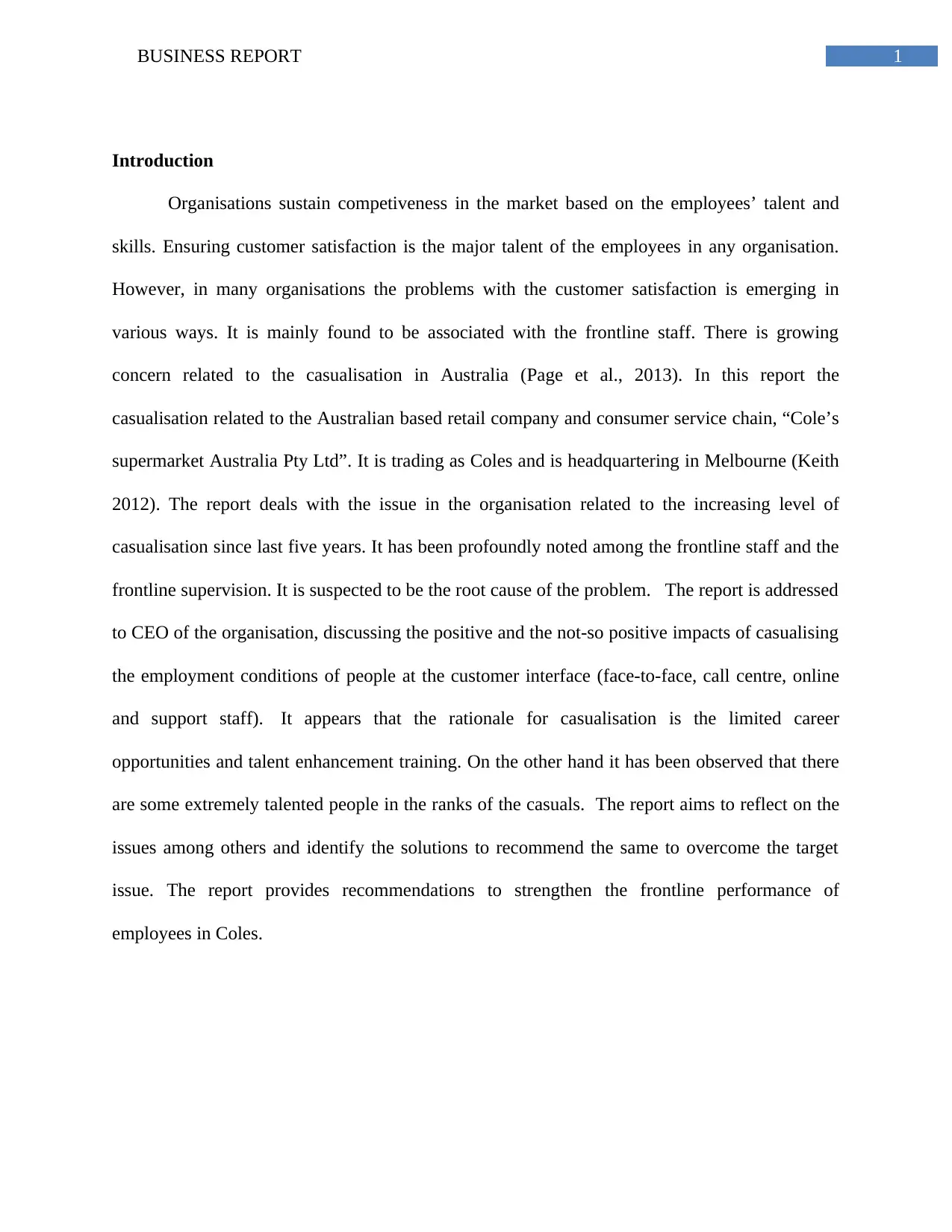
1BUSINESS REPORT
Introduction
Organisations sustain competiveness in the market based on the employees’ talent and
skills. Ensuring customer satisfaction is the major talent of the employees in any organisation.
However, in many organisations the problems with the customer satisfaction is emerging in
various ways. It is mainly found to be associated with the frontline staff. There is growing
concern related to the casualisation in Australia (Page et al., 2013). In this report the
casualisation related to the Australian based retail company and consumer service chain, “Cole’s
supermarket Australia Pty Ltd”. It is trading as Coles and is headquartering in Melbourne (Keith
2012). The report deals with the issue in the organisation related to the increasing level of
casualisation since last five years. It has been profoundly noted among the frontline staff and the
frontline supervision. It is suspected to be the root cause of the problem. The report is addressed
to CEO of the organisation, discussing the positive and the not-so positive impacts of casualising
the employment conditions of people at the customer interface (face-to-face, call centre, online
and support staff). It appears that the rationale for casualisation is the limited career
opportunities and talent enhancement training. On the other hand it has been observed that there
are some extremely talented people in the ranks of the casuals. The report aims to reflect on the
issues among others and identify the solutions to recommend the same to overcome the target
issue. The report provides recommendations to strengthen the frontline performance of
employees in Coles.
Introduction
Organisations sustain competiveness in the market based on the employees’ talent and
skills. Ensuring customer satisfaction is the major talent of the employees in any organisation.
However, in many organisations the problems with the customer satisfaction is emerging in
various ways. It is mainly found to be associated with the frontline staff. There is growing
concern related to the casualisation in Australia (Page et al., 2013). In this report the
casualisation related to the Australian based retail company and consumer service chain, “Cole’s
supermarket Australia Pty Ltd”. It is trading as Coles and is headquartering in Melbourne (Keith
2012). The report deals with the issue in the organisation related to the increasing level of
casualisation since last five years. It has been profoundly noted among the frontline staff and the
frontline supervision. It is suspected to be the root cause of the problem. The report is addressed
to CEO of the organisation, discussing the positive and the not-so positive impacts of casualising
the employment conditions of people at the customer interface (face-to-face, call centre, online
and support staff). It appears that the rationale for casualisation is the limited career
opportunities and talent enhancement training. On the other hand it has been observed that there
are some extremely talented people in the ranks of the casuals. The report aims to reflect on the
issues among others and identify the solutions to recommend the same to overcome the target
issue. The report provides recommendations to strengthen the frontline performance of
employees in Coles.
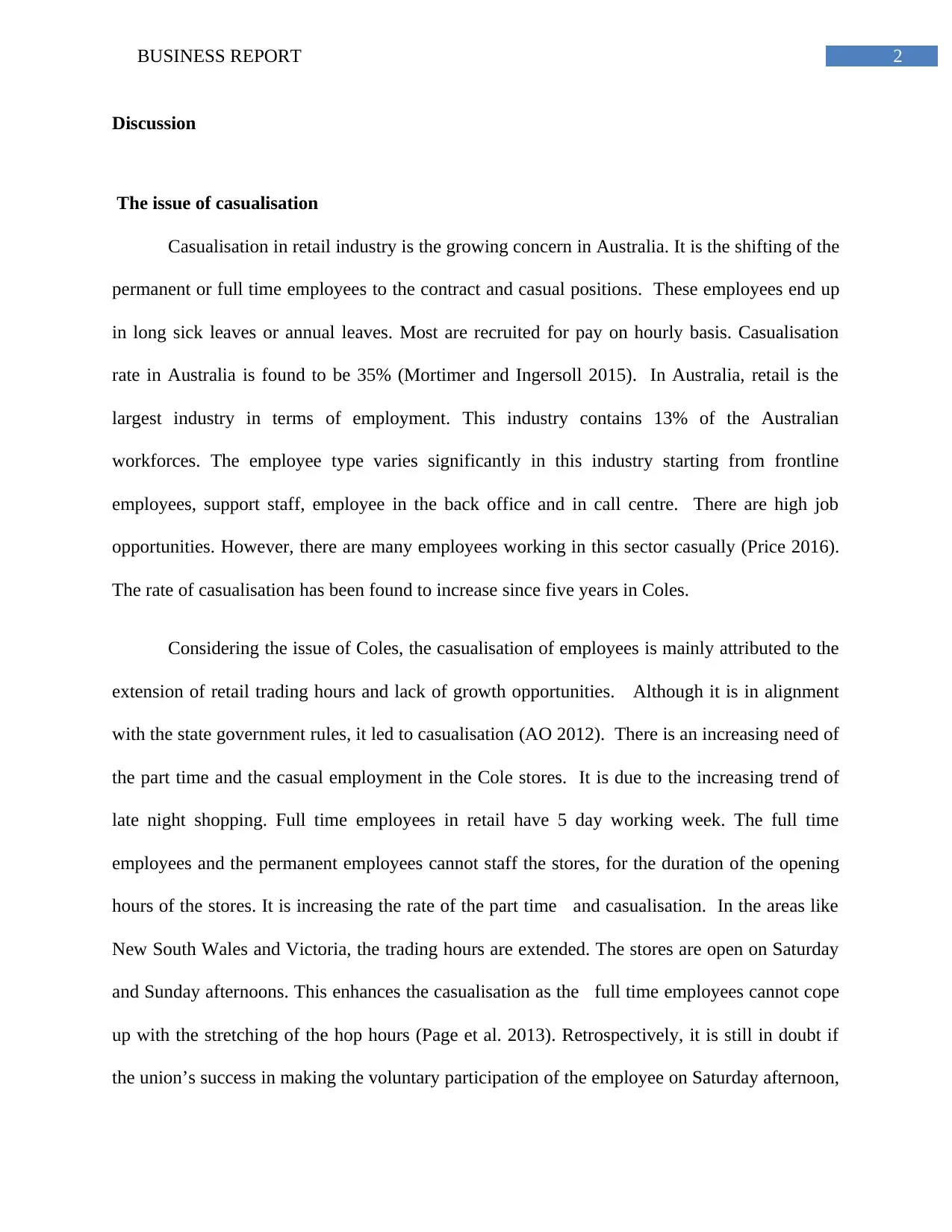
2BUSINESS REPORT
Discussion
The issue of casualisation
Casualisation in retail industry is the growing concern in Australia. It is the shifting of the
permanent or full time employees to the contract and casual positions. These employees end up
in long sick leaves or annual leaves. Most are recruited for pay on hourly basis. Casualisation
rate in Australia is found to be 35% (Mortimer and Ingersoll 2015). In Australia, retail is the
largest industry in terms of employment. This industry contains 13% of the Australian
workforces. The employee type varies significantly in this industry starting from frontline
employees, support staff, employee in the back office and in call centre. There are high job
opportunities. However, there are many employees working in this sector casually (Price 2016).
The rate of casualisation has been found to increase since five years in Coles.
Considering the issue of Coles, the casualisation of employees is mainly attributed to the
extension of retail trading hours and lack of growth opportunities. Although it is in alignment
with the state government rules, it led to casualisation (AO 2012). There is an increasing need of
the part time and the casual employment in the Cole stores. It is due to the increasing trend of
late night shopping. Full time employees in retail have 5 day working week. The full time
employees and the permanent employees cannot staff the stores, for the duration of the opening
hours of the stores. It is increasing the rate of the part time and casualisation. In the areas like
New South Wales and Victoria, the trading hours are extended. The stores are open on Saturday
and Sunday afternoons. This enhances the casualisation as the full time employees cannot cope
up with the stretching of the hop hours (Page et al. 2013). Retrospectively, it is still in doubt if
the union’s success in making the voluntary participation of the employee on Saturday afternoon,
Discussion
The issue of casualisation
Casualisation in retail industry is the growing concern in Australia. It is the shifting of the
permanent or full time employees to the contract and casual positions. These employees end up
in long sick leaves or annual leaves. Most are recruited for pay on hourly basis. Casualisation
rate in Australia is found to be 35% (Mortimer and Ingersoll 2015). In Australia, retail is the
largest industry in terms of employment. This industry contains 13% of the Australian
workforces. The employee type varies significantly in this industry starting from frontline
employees, support staff, employee in the back office and in call centre. There are high job
opportunities. However, there are many employees working in this sector casually (Price 2016).
The rate of casualisation has been found to increase since five years in Coles.
Considering the issue of Coles, the casualisation of employees is mainly attributed to the
extension of retail trading hours and lack of growth opportunities. Although it is in alignment
with the state government rules, it led to casualisation (AO 2012). There is an increasing need of
the part time and the casual employment in the Cole stores. It is due to the increasing trend of
late night shopping. Full time employees in retail have 5 day working week. The full time
employees and the permanent employees cannot staff the stores, for the duration of the opening
hours of the stores. It is increasing the rate of the part time and casualisation. In the areas like
New South Wales and Victoria, the trading hours are extended. The stores are open on Saturday
and Sunday afternoons. This enhances the casualisation as the full time employees cannot cope
up with the stretching of the hop hours (Page et al. 2013). Retrospectively, it is still in doubt if
the union’s success in making the voluntary participation of the employee on Saturday afternoon,
⊘ This is a preview!⊘
Do you want full access?
Subscribe today to unlock all pages.

Trusted by 1+ million students worldwide
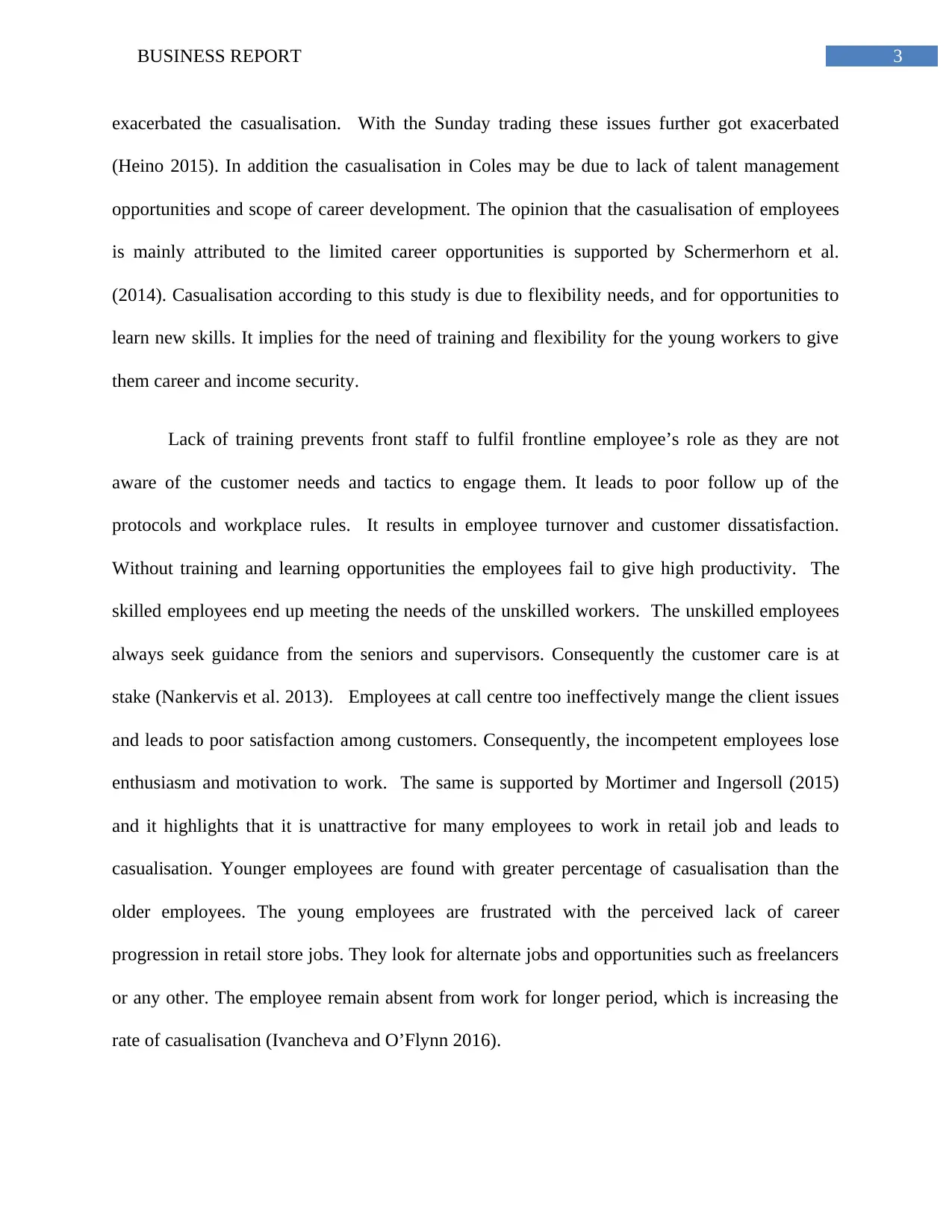
3BUSINESS REPORT
exacerbated the casualisation. With the Sunday trading these issues further got exacerbated
(Heino 2015). In addition the casualisation in Coles may be due to lack of talent management
opportunities and scope of career development. The opinion that the casualisation of employees
is mainly attributed to the limited career opportunities is supported by Schermerhorn et al.
(2014). Casualisation according to this study is due to flexibility needs, and for opportunities to
learn new skills. It implies for the need of training and flexibility for the young workers to give
them career and income security.
Lack of training prevents front staff to fulfil frontline employee’s role as they are not
aware of the customer needs and tactics to engage them. It leads to poor follow up of the
protocols and workplace rules. It results in employee turnover and customer dissatisfaction.
Without training and learning opportunities the employees fail to give high productivity. The
skilled employees end up meeting the needs of the unskilled workers. The unskilled employees
always seek guidance from the seniors and supervisors. Consequently the customer care is at
stake (Nankervis et al. 2013). Employees at call centre too ineffectively mange the client issues
and leads to poor satisfaction among customers. Consequently, the incompetent employees lose
enthusiasm and motivation to work. The same is supported by Mortimer and Ingersoll (2015)
and it highlights that it is unattractive for many employees to work in retail job and leads to
casualisation. Younger employees are found with greater percentage of casualisation than the
older employees. The young employees are frustrated with the perceived lack of career
progression in retail store jobs. They look for alternate jobs and opportunities such as freelancers
or any other. The employee remain absent from work for longer period, which is increasing the
rate of casualisation (Ivancheva and O’Flynn 2016).
exacerbated the casualisation. With the Sunday trading these issues further got exacerbated
(Heino 2015). In addition the casualisation in Coles may be due to lack of talent management
opportunities and scope of career development. The opinion that the casualisation of employees
is mainly attributed to the limited career opportunities is supported by Schermerhorn et al.
(2014). Casualisation according to this study is due to flexibility needs, and for opportunities to
learn new skills. It implies for the need of training and flexibility for the young workers to give
them career and income security.
Lack of training prevents front staff to fulfil frontline employee’s role as they are not
aware of the customer needs and tactics to engage them. It leads to poor follow up of the
protocols and workplace rules. It results in employee turnover and customer dissatisfaction.
Without training and learning opportunities the employees fail to give high productivity. The
skilled employees end up meeting the needs of the unskilled workers. The unskilled employees
always seek guidance from the seniors and supervisors. Consequently the customer care is at
stake (Nankervis et al. 2013). Employees at call centre too ineffectively mange the client issues
and leads to poor satisfaction among customers. Consequently, the incompetent employees lose
enthusiasm and motivation to work. The same is supported by Mortimer and Ingersoll (2015)
and it highlights that it is unattractive for many employees to work in retail job and leads to
casualisation. Younger employees are found with greater percentage of casualisation than the
older employees. The young employees are frustrated with the perceived lack of career
progression in retail store jobs. They look for alternate jobs and opportunities such as freelancers
or any other. The employee remain absent from work for longer period, which is increasing the
rate of casualisation (Ivancheva and O’Flynn 2016).
Paraphrase This Document
Need a fresh take? Get an instant paraphrase of this document with our AI Paraphraser
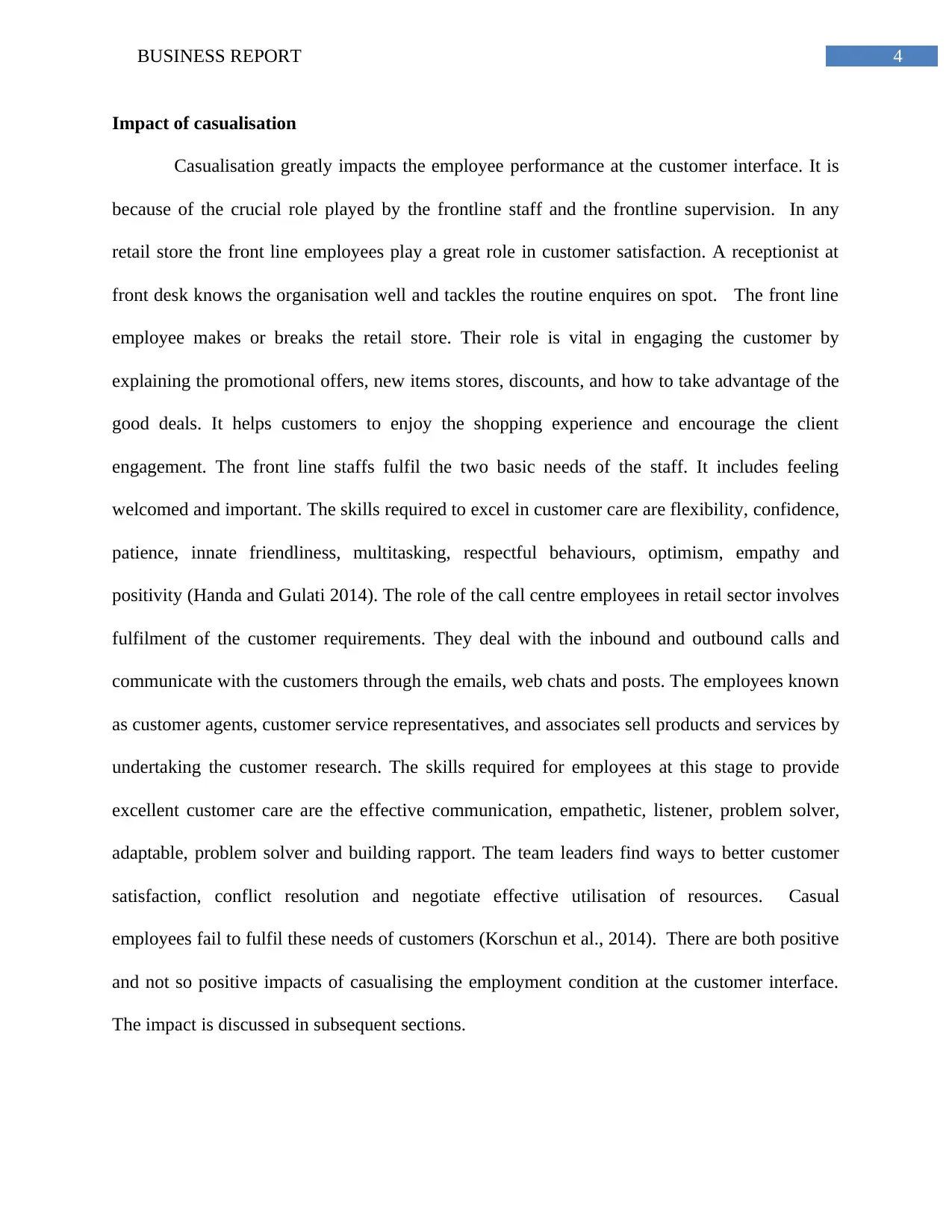
4BUSINESS REPORT
Impact of casualisation
Casualisation greatly impacts the employee performance at the customer interface. It is
because of the crucial role played by the frontline staff and the frontline supervision. In any
retail store the front line employees play a great role in customer satisfaction. A receptionist at
front desk knows the organisation well and tackles the routine enquires on spot. The front line
employee makes or breaks the retail store. Their role is vital in engaging the customer by
explaining the promotional offers, new items stores, discounts, and how to take advantage of the
good deals. It helps customers to enjoy the shopping experience and encourage the client
engagement. The front line staffs fulfil the two basic needs of the staff. It includes feeling
welcomed and important. The skills required to excel in customer care are flexibility, confidence,
patience, innate friendliness, multitasking, respectful behaviours, optimism, empathy and
positivity (Handa and Gulati 2014). The role of the call centre employees in retail sector involves
fulfilment of the customer requirements. They deal with the inbound and outbound calls and
communicate with the customers through the emails, web chats and posts. The employees known
as customer agents, customer service representatives, and associates sell products and services by
undertaking the customer research. The skills required for employees at this stage to provide
excellent customer care are the effective communication, empathetic, listener, problem solver,
adaptable, problem solver and building rapport. The team leaders find ways to better customer
satisfaction, conflict resolution and negotiate effective utilisation of resources. Casual
employees fail to fulfil these needs of customers (Korschun et al., 2014). There are both positive
and not so positive impacts of casualising the employment condition at the customer interface.
The impact is discussed in subsequent sections.
Impact of casualisation
Casualisation greatly impacts the employee performance at the customer interface. It is
because of the crucial role played by the frontline staff and the frontline supervision. In any
retail store the front line employees play a great role in customer satisfaction. A receptionist at
front desk knows the organisation well and tackles the routine enquires on spot. The front line
employee makes or breaks the retail store. Their role is vital in engaging the customer by
explaining the promotional offers, new items stores, discounts, and how to take advantage of the
good deals. It helps customers to enjoy the shopping experience and encourage the client
engagement. The front line staffs fulfil the two basic needs of the staff. It includes feeling
welcomed and important. The skills required to excel in customer care are flexibility, confidence,
patience, innate friendliness, multitasking, respectful behaviours, optimism, empathy and
positivity (Handa and Gulati 2014). The role of the call centre employees in retail sector involves
fulfilment of the customer requirements. They deal with the inbound and outbound calls and
communicate with the customers through the emails, web chats and posts. The employees known
as customer agents, customer service representatives, and associates sell products and services by
undertaking the customer research. The skills required for employees at this stage to provide
excellent customer care are the effective communication, empathetic, listener, problem solver,
adaptable, problem solver and building rapport. The team leaders find ways to better customer
satisfaction, conflict resolution and negotiate effective utilisation of resources. Casual
employees fail to fulfil these needs of customers (Korschun et al., 2014). There are both positive
and not so positive impacts of casualising the employment condition at the customer interface.
The impact is discussed in subsequent sections.
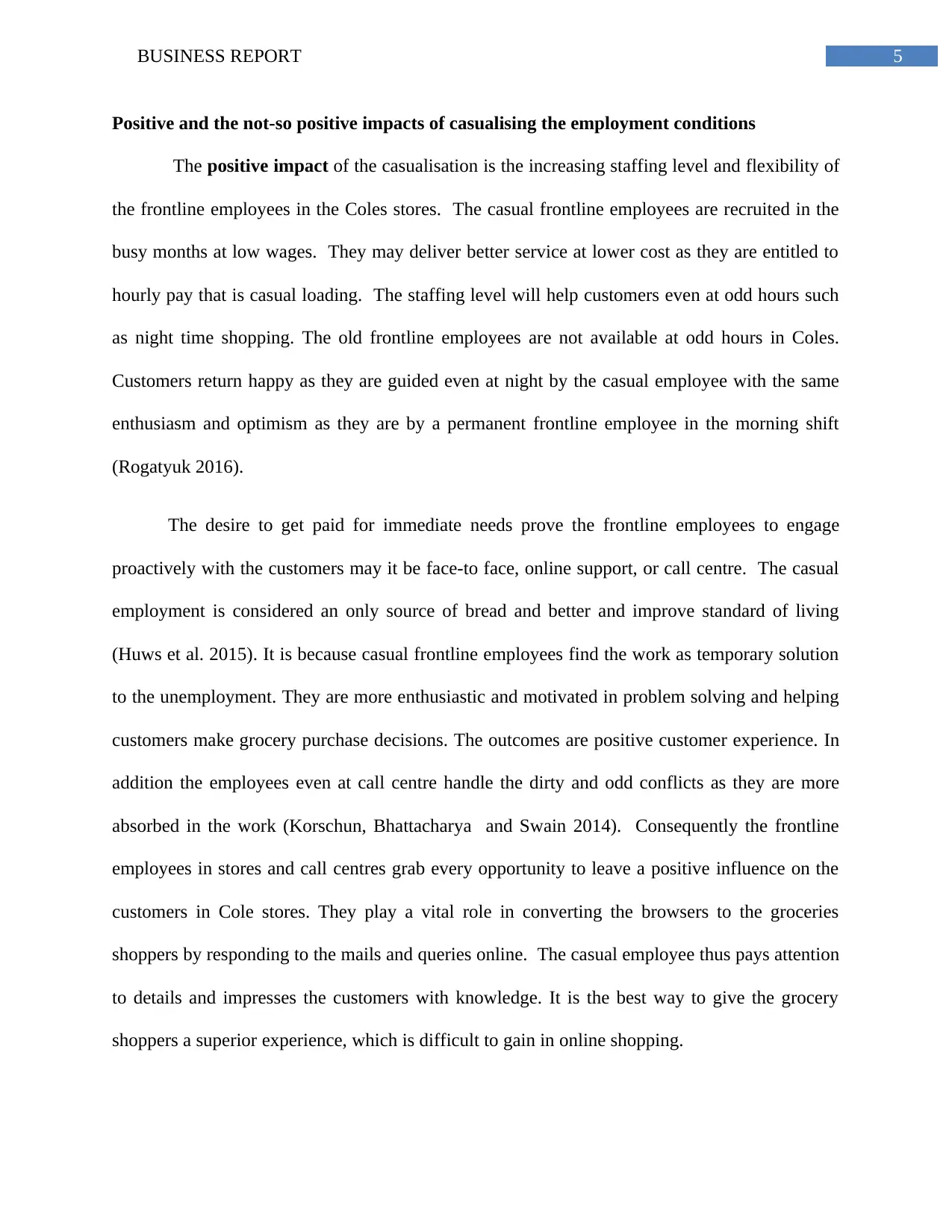
5BUSINESS REPORT
Positive and the not-so positive impacts of casualising the employment conditions
The positive impact of the casualisation is the increasing staffing level and flexibility of
the frontline employees in the Coles stores. The casual frontline employees are recruited in the
busy months at low wages. They may deliver better service at lower cost as they are entitled to
hourly pay that is casual loading. The staffing level will help customers even at odd hours such
as night time shopping. The old frontline employees are not available at odd hours in Coles.
Customers return happy as they are guided even at night by the casual employee with the same
enthusiasm and optimism as they are by a permanent frontline employee in the morning shift
(Rogatyuk 2016).
The desire to get paid for immediate needs prove the frontline employees to engage
proactively with the customers may it be face-to face, online support, or call centre. The casual
employment is considered an only source of bread and better and improve standard of living
(Huws et al. 2015). It is because casual frontline employees find the work as temporary solution
to the unemployment. They are more enthusiastic and motivated in problem solving and helping
customers make grocery purchase decisions. The outcomes are positive customer experience. In
addition the employees even at call centre handle the dirty and odd conflicts as they are more
absorbed in the work (Korschun, Bhattacharya and Swain 2014). Consequently the frontline
employees in stores and call centres grab every opportunity to leave a positive influence on the
customers in Cole stores. They play a vital role in converting the browsers to the groceries
shoppers by responding to the mails and queries online. The casual employee thus pays attention
to details and impresses the customers with knowledge. It is the best way to give the grocery
shoppers a superior experience, which is difficult to gain in online shopping.
Positive and the not-so positive impacts of casualising the employment conditions
The positive impact of the casualisation is the increasing staffing level and flexibility of
the frontline employees in the Coles stores. The casual frontline employees are recruited in the
busy months at low wages. They may deliver better service at lower cost as they are entitled to
hourly pay that is casual loading. The staffing level will help customers even at odd hours such
as night time shopping. The old frontline employees are not available at odd hours in Coles.
Customers return happy as they are guided even at night by the casual employee with the same
enthusiasm and optimism as they are by a permanent frontline employee in the morning shift
(Rogatyuk 2016).
The desire to get paid for immediate needs prove the frontline employees to engage
proactively with the customers may it be face-to face, online support, or call centre. The casual
employment is considered an only source of bread and better and improve standard of living
(Huws et al. 2015). It is because casual frontline employees find the work as temporary solution
to the unemployment. They are more enthusiastic and motivated in problem solving and helping
customers make grocery purchase decisions. The outcomes are positive customer experience. In
addition the employees even at call centre handle the dirty and odd conflicts as they are more
absorbed in the work (Korschun, Bhattacharya and Swain 2014). Consequently the frontline
employees in stores and call centres grab every opportunity to leave a positive influence on the
customers in Cole stores. They play a vital role in converting the browsers to the groceries
shoppers by responding to the mails and queries online. The casual employee thus pays attention
to details and impresses the customers with knowledge. It is the best way to give the grocery
shoppers a superior experience, which is difficult to gain in online shopping.
⊘ This is a preview!⊘
Do you want full access?
Subscribe today to unlock all pages.

Trusted by 1+ million students worldwide
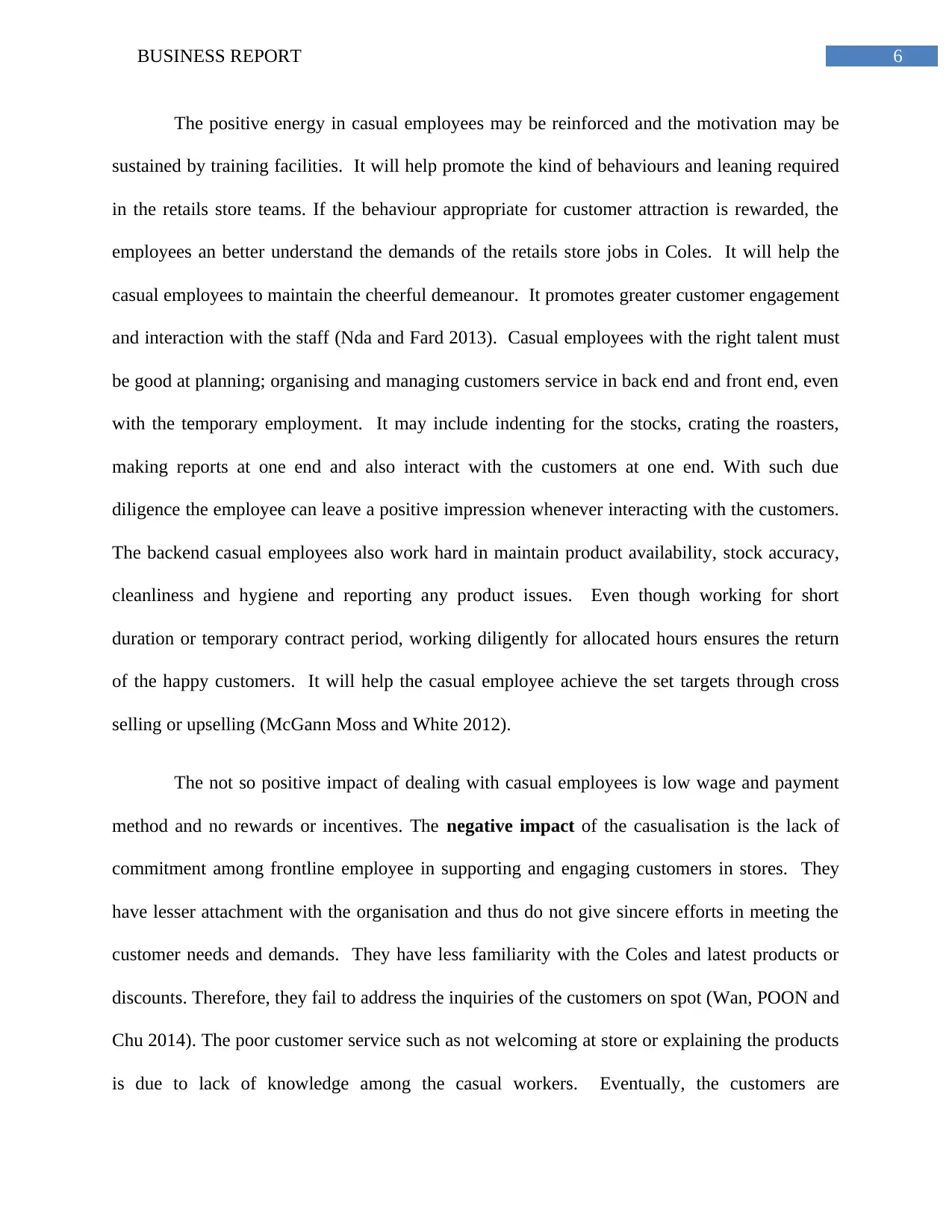
6BUSINESS REPORT
The positive energy in casual employees may be reinforced and the motivation may be
sustained by training facilities. It will help promote the kind of behaviours and leaning required
in the retails store teams. If the behaviour appropriate for customer attraction is rewarded, the
employees an better understand the demands of the retails store jobs in Coles. It will help the
casual employees to maintain the cheerful demeanour. It promotes greater customer engagement
and interaction with the staff (Nda and Fard 2013). Casual employees with the right talent must
be good at planning; organising and managing customers service in back end and front end, even
with the temporary employment. It may include indenting for the stocks, crating the roasters,
making reports at one end and also interact with the customers at one end. With such due
diligence the employee can leave a positive impression whenever interacting with the customers.
The backend casual employees also work hard in maintain product availability, stock accuracy,
cleanliness and hygiene and reporting any product issues. Even though working for short
duration or temporary contract period, working diligently for allocated hours ensures the return
of the happy customers. It will help the casual employee achieve the set targets through cross
selling or upselling (McGann Moss and White 2012).
The not so positive impact of dealing with casual employees is low wage and payment
method and no rewards or incentives. The negative impact of the casualisation is the lack of
commitment among frontline employee in supporting and engaging customers in stores. They
have lesser attachment with the organisation and thus do not give sincere efforts in meeting the
customer needs and demands. They have less familiarity with the Coles and latest products or
discounts. Therefore, they fail to address the inquiries of the customers on spot (Wan, POON and
Chu 2014). The poor customer service such as not welcoming at store or explaining the products
is due to lack of knowledge among the casual workers. Eventually, the customers are
The positive energy in casual employees may be reinforced and the motivation may be
sustained by training facilities. It will help promote the kind of behaviours and leaning required
in the retails store teams. If the behaviour appropriate for customer attraction is rewarded, the
employees an better understand the demands of the retails store jobs in Coles. It will help the
casual employees to maintain the cheerful demeanour. It promotes greater customer engagement
and interaction with the staff (Nda and Fard 2013). Casual employees with the right talent must
be good at planning; organising and managing customers service in back end and front end, even
with the temporary employment. It may include indenting for the stocks, crating the roasters,
making reports at one end and also interact with the customers at one end. With such due
diligence the employee can leave a positive impression whenever interacting with the customers.
The backend casual employees also work hard in maintain product availability, stock accuracy,
cleanliness and hygiene and reporting any product issues. Even though working for short
duration or temporary contract period, working diligently for allocated hours ensures the return
of the happy customers. It will help the casual employee achieve the set targets through cross
selling or upselling (McGann Moss and White 2012).
The not so positive impact of dealing with casual employees is low wage and payment
method and no rewards or incentives. The negative impact of the casualisation is the lack of
commitment among frontline employee in supporting and engaging customers in stores. They
have lesser attachment with the organisation and thus do not give sincere efforts in meeting the
customer needs and demands. They have less familiarity with the Coles and latest products or
discounts. Therefore, they fail to address the inquiries of the customers on spot (Wan, POON and
Chu 2014). The poor customer service such as not welcoming at store or explaining the products
is due to lack of knowledge among the casual workers. Eventually, the customers are
Paraphrase This Document
Need a fresh take? Get an instant paraphrase of this document with our AI Paraphraser
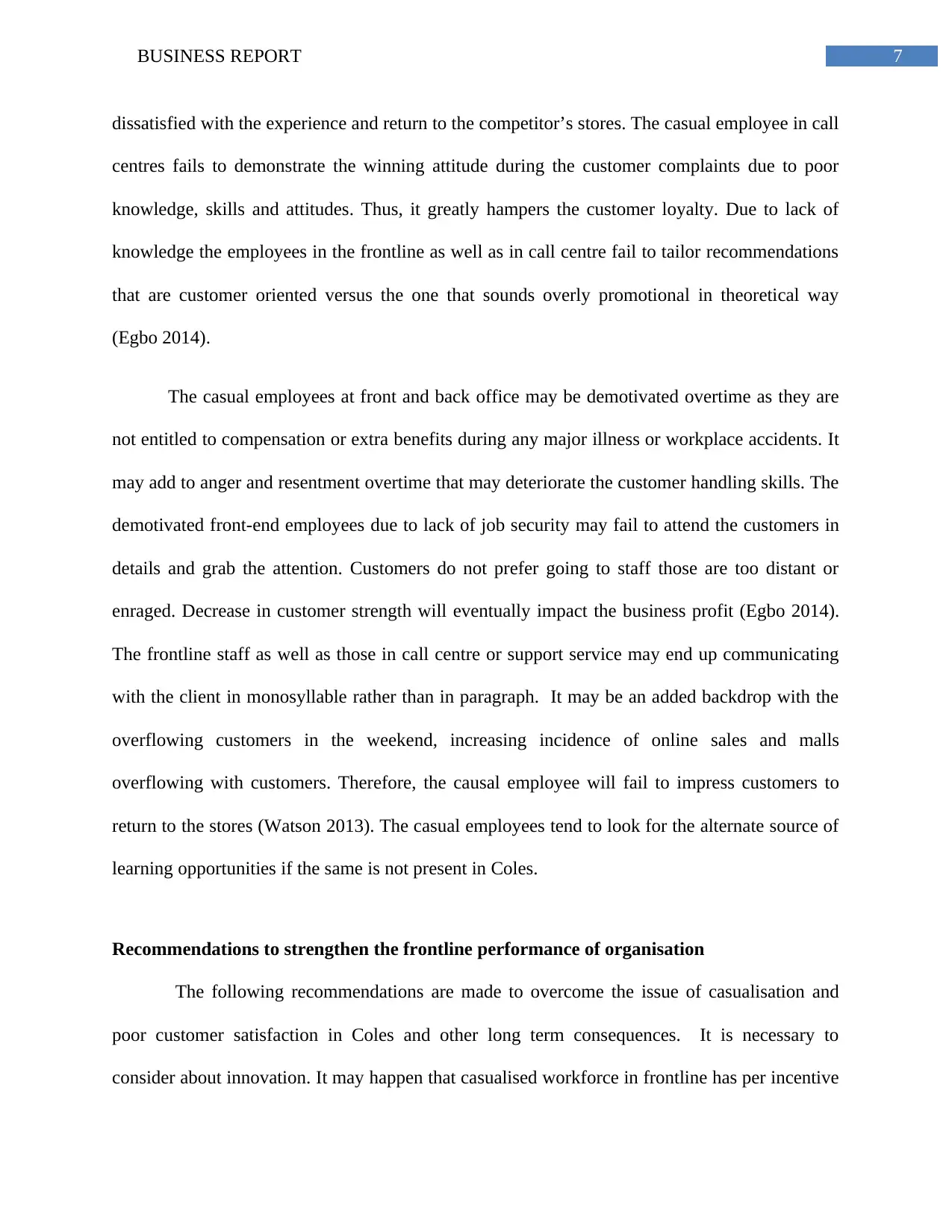
7BUSINESS REPORT
dissatisfied with the experience and return to the competitor’s stores. The casual employee in call
centres fails to demonstrate the winning attitude during the customer complaints due to poor
knowledge, skills and attitudes. Thus, it greatly hampers the customer loyalty. Due to lack of
knowledge the employees in the frontline as well as in call centre fail to tailor recommendations
that are customer oriented versus the one that sounds overly promotional in theoretical way
(Egbo 2014).
The casual employees at front and back office may be demotivated overtime as they are
not entitled to compensation or extra benefits during any major illness or workplace accidents. It
may add to anger and resentment overtime that may deteriorate the customer handling skills. The
demotivated front-end employees due to lack of job security may fail to attend the customers in
details and grab the attention. Customers do not prefer going to staff those are too distant or
enraged. Decrease in customer strength will eventually impact the business profit (Egbo 2014).
The frontline staff as well as those in call centre or support service may end up communicating
with the client in monosyllable rather than in paragraph. It may be an added backdrop with the
overflowing customers in the weekend, increasing incidence of online sales and malls
overflowing with customers. Therefore, the causal employee will fail to impress customers to
return to the stores (Watson 2013). The casual employees tend to look for the alternate source of
learning opportunities if the same is not present in Coles.
Recommendations to strengthen the frontline performance of organisation
The following recommendations are made to overcome the issue of casualisation and
poor customer satisfaction in Coles and other long term consequences. It is necessary to
consider about innovation. It may happen that casualised workforce in frontline has per incentive
dissatisfied with the experience and return to the competitor’s stores. The casual employee in call
centres fails to demonstrate the winning attitude during the customer complaints due to poor
knowledge, skills and attitudes. Thus, it greatly hampers the customer loyalty. Due to lack of
knowledge the employees in the frontline as well as in call centre fail to tailor recommendations
that are customer oriented versus the one that sounds overly promotional in theoretical way
(Egbo 2014).
The casual employees at front and back office may be demotivated overtime as they are
not entitled to compensation or extra benefits during any major illness or workplace accidents. It
may add to anger and resentment overtime that may deteriorate the customer handling skills. The
demotivated front-end employees due to lack of job security may fail to attend the customers in
details and grab the attention. Customers do not prefer going to staff those are too distant or
enraged. Decrease in customer strength will eventually impact the business profit (Egbo 2014).
The frontline staff as well as those in call centre or support service may end up communicating
with the client in monosyllable rather than in paragraph. It may be an added backdrop with the
overflowing customers in the weekend, increasing incidence of online sales and malls
overflowing with customers. Therefore, the causal employee will fail to impress customers to
return to the stores (Watson 2013). The casual employees tend to look for the alternate source of
learning opportunities if the same is not present in Coles.
Recommendations to strengthen the frontline performance of organisation
The following recommendations are made to overcome the issue of casualisation and
poor customer satisfaction in Coles and other long term consequences. It is necessary to
consider about innovation. It may happen that casualised workforce in frontline has per incentive
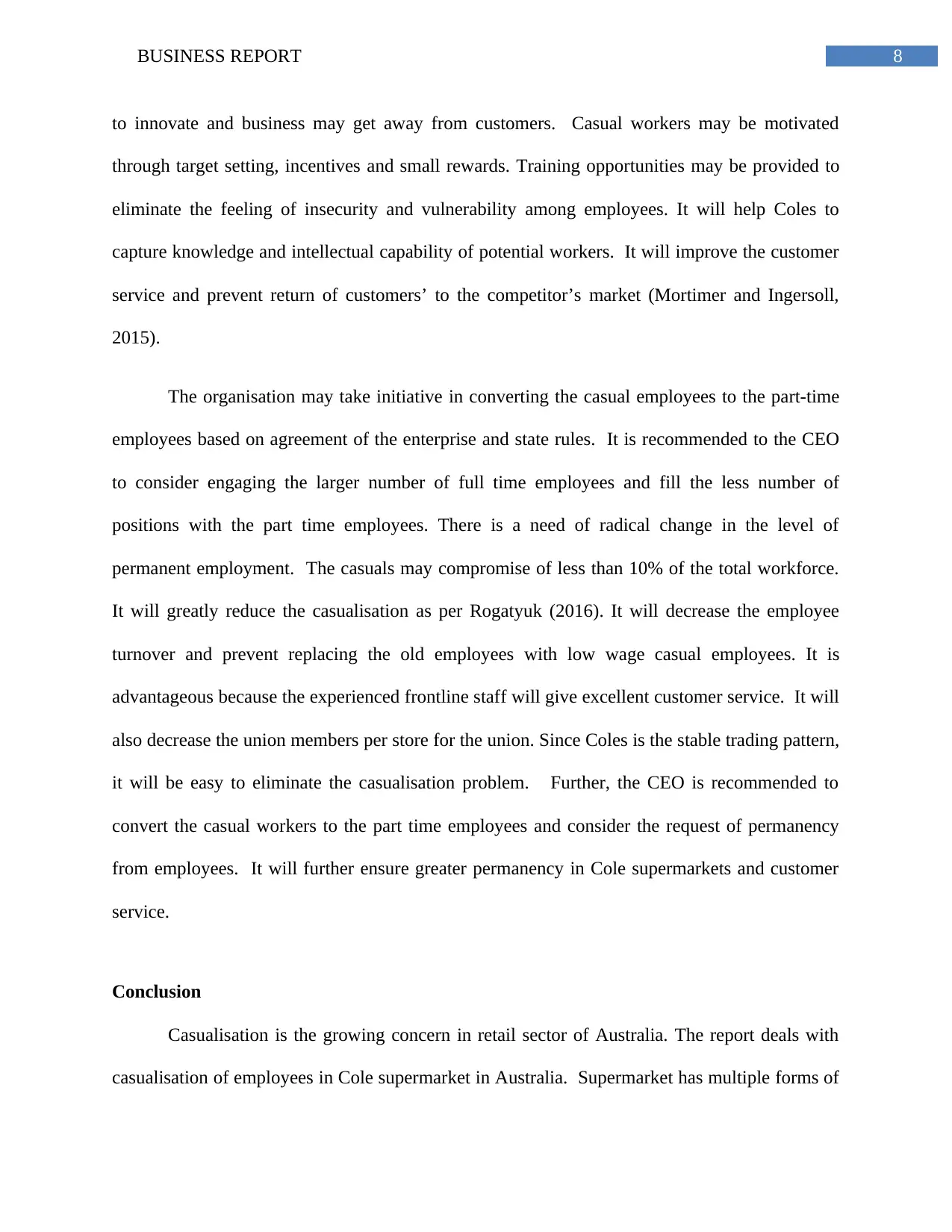
8BUSINESS REPORT
to innovate and business may get away from customers. Casual workers may be motivated
through target setting, incentives and small rewards. Training opportunities may be provided to
eliminate the feeling of insecurity and vulnerability among employees. It will help Coles to
capture knowledge and intellectual capability of potential workers. It will improve the customer
service and prevent return of customers’ to the competitor’s market (Mortimer and Ingersoll,
2015).
The organisation may take initiative in converting the casual employees to the part-time
employees based on agreement of the enterprise and state rules. It is recommended to the CEO
to consider engaging the larger number of full time employees and fill the less number of
positions with the part time employees. There is a need of radical change in the level of
permanent employment. The casuals may compromise of less than 10% of the total workforce.
It will greatly reduce the casualisation as per Rogatyuk (2016). It will decrease the employee
turnover and prevent replacing the old employees with low wage casual employees. It is
advantageous because the experienced frontline staff will give excellent customer service. It will
also decrease the union members per store for the union. Since Coles is the stable trading pattern,
it will be easy to eliminate the casualisation problem. Further, the CEO is recommended to
convert the casual workers to the part time employees and consider the request of permanency
from employees. It will further ensure greater permanency in Cole supermarkets and customer
service.
Conclusion
Casualisation is the growing concern in retail sector of Australia. The report deals with
casualisation of employees in Cole supermarket in Australia. Supermarket has multiple forms of
to innovate and business may get away from customers. Casual workers may be motivated
through target setting, incentives and small rewards. Training opportunities may be provided to
eliminate the feeling of insecurity and vulnerability among employees. It will help Coles to
capture knowledge and intellectual capability of potential workers. It will improve the customer
service and prevent return of customers’ to the competitor’s market (Mortimer and Ingersoll,
2015).
The organisation may take initiative in converting the casual employees to the part-time
employees based on agreement of the enterprise and state rules. It is recommended to the CEO
to consider engaging the larger number of full time employees and fill the less number of
positions with the part time employees. There is a need of radical change in the level of
permanent employment. The casuals may compromise of less than 10% of the total workforce.
It will greatly reduce the casualisation as per Rogatyuk (2016). It will decrease the employee
turnover and prevent replacing the old employees with low wage casual employees. It is
advantageous because the experienced frontline staff will give excellent customer service. It will
also decrease the union members per store for the union. Since Coles is the stable trading pattern,
it will be easy to eliminate the casualisation problem. Further, the CEO is recommended to
convert the casual workers to the part time employees and consider the request of permanency
from employees. It will further ensure greater permanency in Cole supermarkets and customer
service.
Conclusion
Casualisation is the growing concern in retail sector of Australia. The report deals with
casualisation of employees in Cole supermarket in Australia. Supermarket has multiple forms of
⊘ This is a preview!⊘
Do you want full access?
Subscribe today to unlock all pages.

Trusted by 1+ million students worldwide
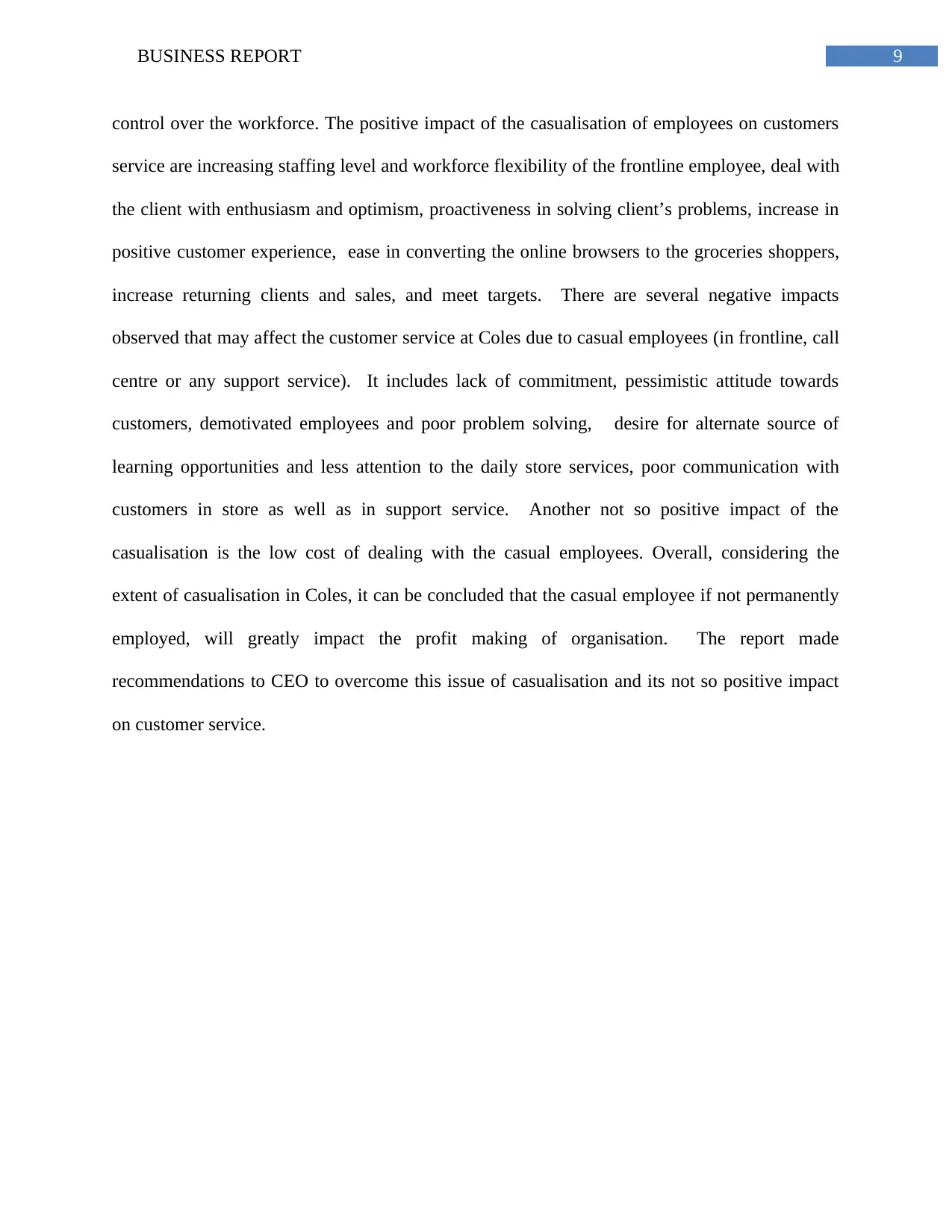
9BUSINESS REPORT
control over the workforce. The positive impact of the casualisation of employees on customers
service are increasing staffing level and workforce flexibility of the frontline employee, deal with
the client with enthusiasm and optimism, proactiveness in solving client’s problems, increase in
positive customer experience, ease in converting the online browsers to the groceries shoppers,
increase returning clients and sales, and meet targets. There are several negative impacts
observed that may affect the customer service at Coles due to casual employees (in frontline, call
centre or any support service). It includes lack of commitment, pessimistic attitude towards
customers, demotivated employees and poor problem solving, desire for alternate source of
learning opportunities and less attention to the daily store services, poor communication with
customers in store as well as in support service. Another not so positive impact of the
casualisation is the low cost of dealing with the casual employees. Overall, considering the
extent of casualisation in Coles, it can be concluded that the casual employee if not permanently
employed, will greatly impact the profit making of organisation. The report made
recommendations to CEO to overcome this issue of casualisation and its not so positive impact
on customer service.
control over the workforce. The positive impact of the casualisation of employees on customers
service are increasing staffing level and workforce flexibility of the frontline employee, deal with
the client with enthusiasm and optimism, proactiveness in solving client’s problems, increase in
positive customer experience, ease in converting the online browsers to the groceries shoppers,
increase returning clients and sales, and meet targets. There are several negative impacts
observed that may affect the customer service at Coles due to casual employees (in frontline, call
centre or any support service). It includes lack of commitment, pessimistic attitude towards
customers, demotivated employees and poor problem solving, desire for alternate source of
learning opportunities and less attention to the daily store services, poor communication with
customers in store as well as in support service. Another not so positive impact of the
casualisation is the low cost of dealing with the casual employees. Overall, considering the
extent of casualisation in Coles, it can be concluded that the casual employee if not permanently
employed, will greatly impact the profit making of organisation. The report made
recommendations to CEO to overcome this issue of casualisation and its not so positive impact
on customer service.
Paraphrase This Document
Need a fresh take? Get an instant paraphrase of this document with our AI Paraphraser
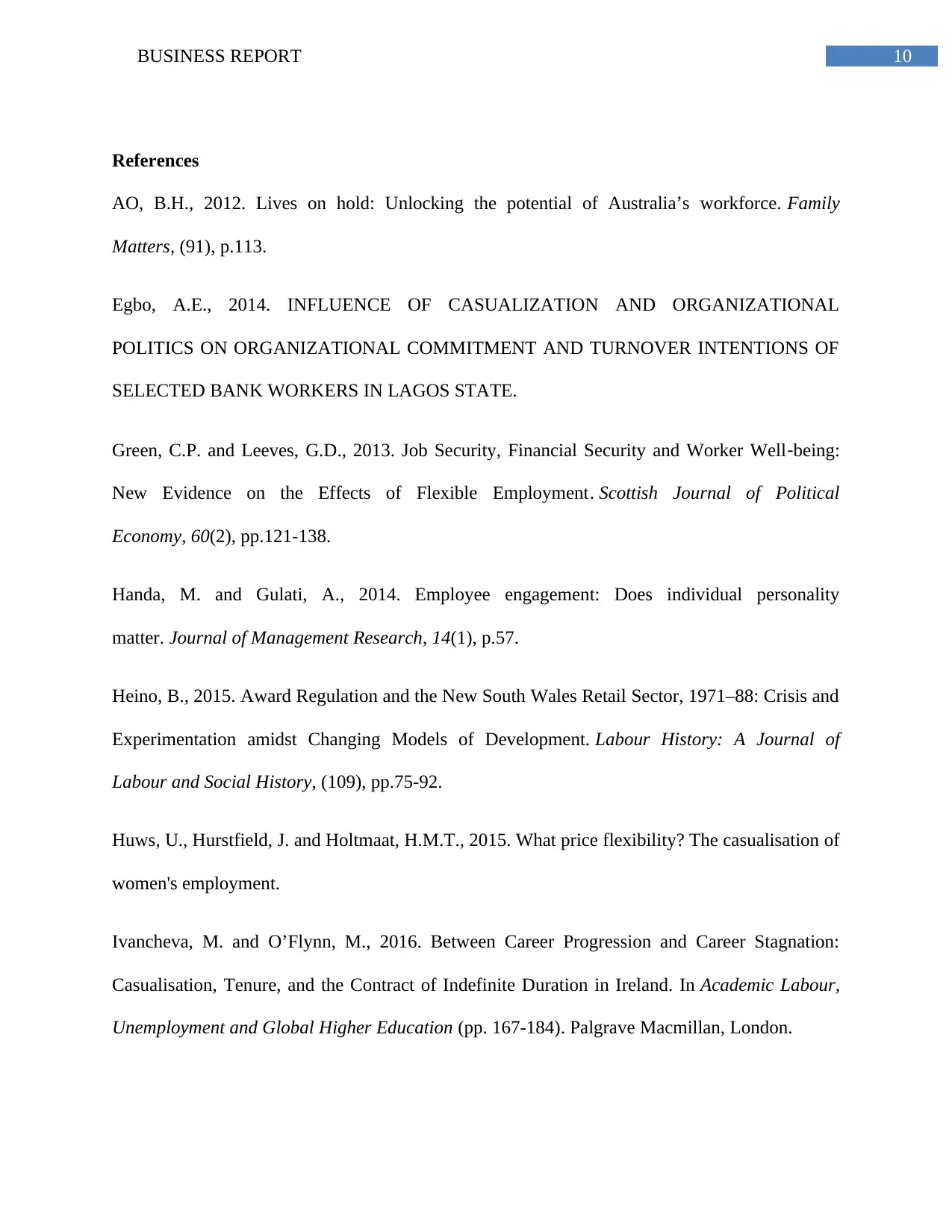
10BUSINESS REPORT
References
AO, B.H., 2012. Lives on hold: Unlocking the potential of Australia’s workforce. Family
Matters, (91), p.113.
Egbo, A.E., 2014. INFLUENCE OF CASUALIZATION AND ORGANIZATIONAL
POLITICS ON ORGANIZATIONAL COMMITMENT AND TURNOVER INTENTIONS OF
SELECTED BANK WORKERS IN LAGOS STATE.
Green, C.P. and Leeves, G.D., 2013. Job Security, Financial Security and Worker Well‐being:
New Evidence on the Effects of Flexible Employment. Scottish Journal of Political
Economy, 60(2), pp.121-138.
Handa, M. and Gulati, A., 2014. Employee engagement: Does individual personality
matter. Journal of Management Research, 14(1), p.57.
Heino, B., 2015. Award Regulation and the New South Wales Retail Sector, 1971–88: Crisis and
Experimentation amidst Changing Models of Development. Labour History: A Journal of
Labour and Social History, (109), pp.75-92.
Huws, U., Hurstfield, J. and Holtmaat, H.M.T., 2015. What price flexibility? The casualisation of
women's employment.
Ivancheva, M. and O’Flynn, M., 2016. Between Career Progression and Career Stagnation:
Casualisation, Tenure, and the Contract of Indefinite Duration in Ireland. In Academic Labour,
Unemployment and Global Higher Education (pp. 167-184). Palgrave Macmillan, London.
References
AO, B.H., 2012. Lives on hold: Unlocking the potential of Australia’s workforce. Family
Matters, (91), p.113.
Egbo, A.E., 2014. INFLUENCE OF CASUALIZATION AND ORGANIZATIONAL
POLITICS ON ORGANIZATIONAL COMMITMENT AND TURNOVER INTENTIONS OF
SELECTED BANK WORKERS IN LAGOS STATE.
Green, C.P. and Leeves, G.D., 2013. Job Security, Financial Security and Worker Well‐being:
New Evidence on the Effects of Flexible Employment. Scottish Journal of Political
Economy, 60(2), pp.121-138.
Handa, M. and Gulati, A., 2014. Employee engagement: Does individual personality
matter. Journal of Management Research, 14(1), p.57.
Heino, B., 2015. Award Regulation and the New South Wales Retail Sector, 1971–88: Crisis and
Experimentation amidst Changing Models of Development. Labour History: A Journal of
Labour and Social History, (109), pp.75-92.
Huws, U., Hurstfield, J. and Holtmaat, H.M.T., 2015. What price flexibility? The casualisation of
women's employment.
Ivancheva, M. and O’Flynn, M., 2016. Between Career Progression and Career Stagnation:
Casualisation, Tenure, and the Contract of Indefinite Duration in Ireland. In Academic Labour,
Unemployment and Global Higher Education (pp. 167-184). Palgrave Macmillan, London.
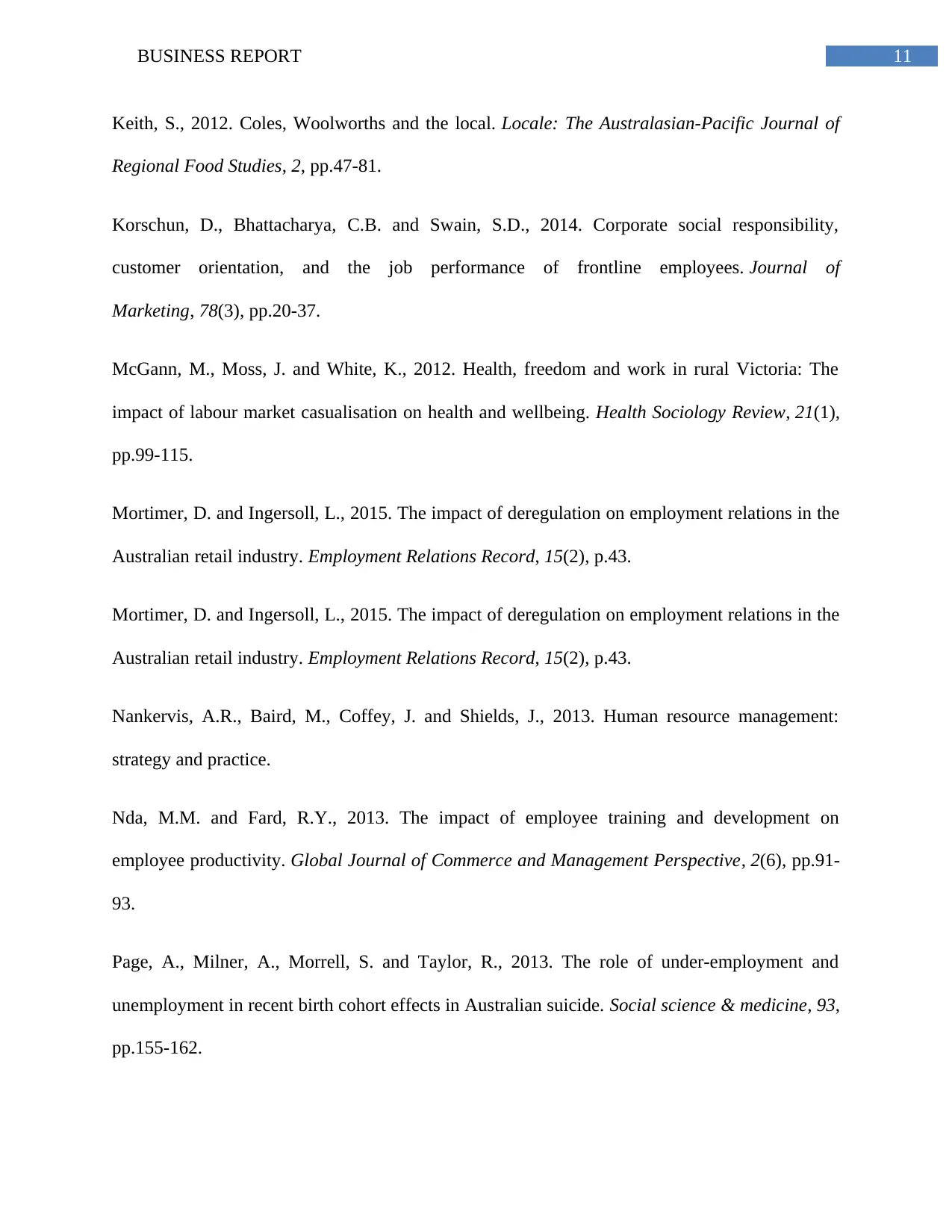
11BUSINESS REPORT
Keith, S., 2012. Coles, Woolworths and the local. Locale: The Australasian-Pacific Journal of
Regional Food Studies, 2, pp.47-81.
Korschun, D., Bhattacharya, C.B. and Swain, S.D., 2014. Corporate social responsibility,
customer orientation, and the job performance of frontline employees. Journal of
Marketing, 78(3), pp.20-37.
McGann, M., Moss, J. and White, K., 2012. Health, freedom and work in rural Victoria: The
impact of labour market casualisation on health and wellbeing. Health Sociology Review, 21(1),
pp.99-115.
Mortimer, D. and Ingersoll, L., 2015. The impact of deregulation on employment relations in the
Australian retail industry. Employment Relations Record, 15(2), p.43.
Mortimer, D. and Ingersoll, L., 2015. The impact of deregulation on employment relations in the
Australian retail industry. Employment Relations Record, 15(2), p.43.
Nankervis, A.R., Baird, M., Coffey, J. and Shields, J., 2013. Human resource management:
strategy and practice.
Nda, M.M. and Fard, R.Y., 2013. The impact of employee training and development on
employee productivity. Global Journal of Commerce and Management Perspective, 2(6), pp.91-
93.
Page, A., Milner, A., Morrell, S. and Taylor, R., 2013. The role of under-employment and
unemployment in recent birth cohort effects in Australian suicide. Social science & medicine, 93,
pp.155-162.
Keith, S., 2012. Coles, Woolworths and the local. Locale: The Australasian-Pacific Journal of
Regional Food Studies, 2, pp.47-81.
Korschun, D., Bhattacharya, C.B. and Swain, S.D., 2014. Corporate social responsibility,
customer orientation, and the job performance of frontline employees. Journal of
Marketing, 78(3), pp.20-37.
McGann, M., Moss, J. and White, K., 2012. Health, freedom and work in rural Victoria: The
impact of labour market casualisation on health and wellbeing. Health Sociology Review, 21(1),
pp.99-115.
Mortimer, D. and Ingersoll, L., 2015. The impact of deregulation on employment relations in the
Australian retail industry. Employment Relations Record, 15(2), p.43.
Mortimer, D. and Ingersoll, L., 2015. The impact of deregulation on employment relations in the
Australian retail industry. Employment Relations Record, 15(2), p.43.
Nankervis, A.R., Baird, M., Coffey, J. and Shields, J., 2013. Human resource management:
strategy and practice.
Nda, M.M. and Fard, R.Y., 2013. The impact of employee training and development on
employee productivity. Global Journal of Commerce and Management Perspective, 2(6), pp.91-
93.
Page, A., Milner, A., Morrell, S. and Taylor, R., 2013. The role of under-employment and
unemployment in recent birth cohort effects in Australian suicide. Social science & medicine, 93,
pp.155-162.
⊘ This is a preview!⊘
Do you want full access?
Subscribe today to unlock all pages.

Trusted by 1+ million students worldwide
1 out of 13
Related Documents
Your All-in-One AI-Powered Toolkit for Academic Success.
+13062052269
info@desklib.com
Available 24*7 on WhatsApp / Email
![[object Object]](/_next/static/media/star-bottom.7253800d.svg)
Unlock your academic potential
Copyright © 2020–2025 A2Z Services. All Rights Reserved. Developed and managed by ZUCOL.





